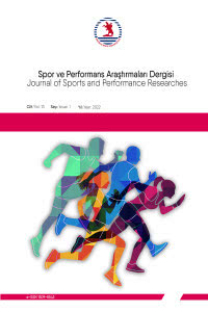ASSESSMENT AND COMPARISON OF VISUAL SKILLS AMONG ATHLETES
Görsel reaksiyon zamanı, Fitlight, motor performans
ASSESSMENT AND COMPARISON OF VISUAL SKILLS AMONG ATHLETES
Fitlight, motor performance, Visual reaction time,
___
- 1. Vickers JN. Advances in coupling perception and action: The quiet eye as a bidirectional link between gaze, attention, and action. Progress in Brain Research, 2009; 174: 279-288.
- 2. Erickson G. Sports Vision: Vision care for the enhancement of sports performance. S.Louis, Butterworth-Heinemann Elsevier, 2007.
- 3. Kirschen DG, Laby DL. The role of sports vision in eye care today. Eye & contact lens, 2011; 37(3): 127-130.
- 4. Davids K, Williams JG, Williams AM. Visual perception and action in sport. Routledge, 2005.
- 5. Mori S, Ohtani Y, Imanaka K. Reaction times and anticipatory skills of karate athletes. Human Movement Science, 2002; 21(2): 213-230.
- 6. Hadlow SM, Panchuk D, Mann DL, Portus MR, Abernethy B. Modified perceptual training in sport: a new classification framework. Journal of Science and Medicine In Sport, 2018.
- 7. Meng KY, Zuhairi NA, Manan FA, Knight VF, Padri MNA, Omar R. Role of gender, age and ethnicities on visual reaction time and visual anticipation time of junior athletes. Australian Journal of Basic and Applied Sciences, 2015; 9(5): 129-134.
- 8. Loureiro Jr LDFB, Freitas PBD. Influence of the performance level in badminton players in neuromotor aspects during a target-pointing task. Revista Brasileira de Medicina do Esporte, 2012; 18(3): 203-207.
- 9. Luce RD. Response Times: Their Role in Inferring Elementary Mental Organization. Oxford University Press, 1986; 3(8).
- 10. Paterson G. Visual-motor response times in athletes and non-athletes (Doctoral dissertation, Stellenbosch: University of Stellenbosch), 2010.
- 11. O’Connor FG, Casa DJ, Davis BA, Pierre PS, Sallis RE, Wilder RP. ACSM’s Sport Medicine A Comprehensive Review, Lippincott Williams & Wilkins, 2012; pg 166.
- 12. Kuan YM, Zuhairi NA, Manan FA, Knight VF, Omar R. Visual reaction time and visual anticipation time between athletes and non-athletes. Malaysian Journal of Public Health Medicine, 2018; Special issue 1: 135-141.
- 13. Zwierko T, Florkiewicz B, Fogtman S, Kszak-Krzyżanowska A. The ability to maintain attention during visuomotor task performance in handball players and non-athletes. Central European Journal of Sport Sciences and Medicine, 2014; 3(7): 99-106.
- 14. Babu RJ, Lillakas L, Irving EL. Dynamics of saccadic adaptation: differences between athletes and nonathletes. Optometry and Vision Science, 2005; 82(12): 1060-1065.
- 15. Vera J, Jiménez R, Cárdenas D, Redondo B, García JA. Visual function, performance, and processing of basketball players versus sedentary individuals. Journal of Sport and Health Science, 2017.
- 16. Del Percio C, Brancucci A, Vecchio F, Marzano N, Pirritano M, Meccariello E, Lino A. Visual event-related potentials in elite and amateur athletes. Brain Research Bulletin, 2007; 74(1-3): 104-112.
- 17. Aksoy Y. Comparison of Sprint Reaction Time and Anaerobic Strength of Young Football, Volleyball and Wrestlers. Master Thesis, 36, 2012.
- 18. Akyuz M, Uzaldi BB, Akyuz Ö, Doğru Y. Comparison of Sprint Reaction and Visual Reaction Times of Athletes in Different Branches. Journal of Education and Training Studies, 2016; 5(1): 94-100.
- 19. Kosinski RJ. A literature review on reaction time. Clemson University, 2008; 10.
- ISSN: 1309-5110
- Yayın Aralığı: 3
- Başlangıç: 2010
- Yayıncı: Ondokuz Mayıs Üniversitesi Yaşar Doğu Spor Bilimleri Fakültesi
SPOR ENDÜSTRİSİNDE MÜŞTERİ BAĞLILIĞI: SPOR AYAKKABISI PAZARINA YÖNELİK BİR ARAŞTIRMA
FİTNESS İŞLETMELERİNE YÖNELİK E-ŞİKÂYETLERİN İÇERİK ANALİZİ İLE İNCELENMESİ
Hüseyin Ertan İNAN, Çağıl Hale ÖZEL
RİO OLİMPİYAT OYUNLARINDA BADMİNTON MÜSABAKALARININ İNCELENMESİ
Anıl TÜRKELİ, Ömer ŞENEL, İrfan GÜLMEZ
ASSESSMENT AND COMPARISON OF VISUAL SKILLS AMONG ATHLETES
Berfin Serdil ÖRS, Fulden CANTAŞ, Elvin ONARICI GÜNGÖR, Deniz ŞİMŞEK
TÜRK SPOR YÖNETİMİNDEKİ MEVCUT SORUNLARLA İLGİLİ ANTRENÖRLERİN GÖRÜŞLERİ
KİLOLU KADINLARDA DÜZENLİ EGZERSİZİN KARACİĞER ENZİM DÜZEYLERİNE ETKİSİ
Vedat ÇINAR, Özlem TUNÇALP, Salih ÖNER, Taner AKBULUT, Yahya POLAT
